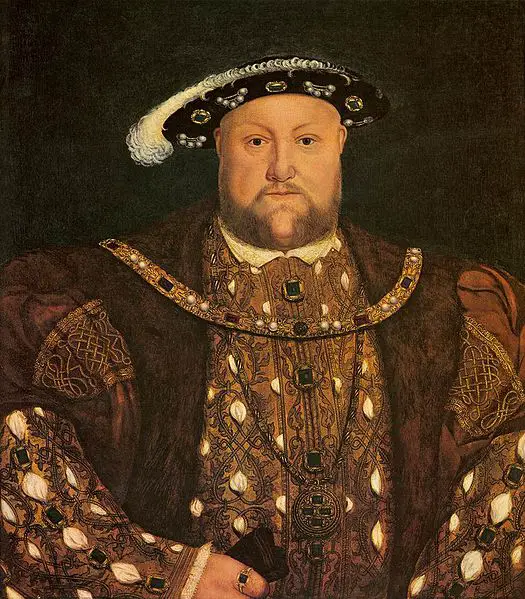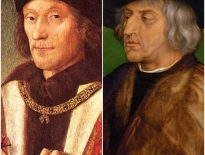This week's Claire Chats talk is the first in as series on the Tudor monarchs: the good, the bad and the ugly. I'm going to be examining each Tudor monarch and their reign, and discussing their accomplishments, the good they did for their people, and also the not so good things of their reign.
Today's Claire Chats is on Henry VII. I'm sure you'll be able to add to my list, so do feel free to comment below.
Nathen Amin's talks on Henry VII:



What a great idea for a series! I’m looking forward to more, for sure! I appreciate your linking the expert talks, as I am not as familiar with Henry VII. Michelle t
Oh, meant to mention, I just added House of Beaufort, by Nathan Amin, to my (growing) Tudor library, in an effort to better understand the lineage, Margaret,and Henry VII as well.
Yes, his taxation and his fiscal policy of fines and benefices against nobles for their loyalty, which was extended to the merchants and business class in London were exploitative, but they were also a different way of doing things, especially as the alternative might be prison or exile or death. His policy was exploited to the full under his ministers, Richard Epsom and Edmund Dudley, who were later accused of excesses and charged with treason in the early months of King Henry Viii, although the Black Books Henry kept show he checked and authorized every transaction and fine. In 1507, there does appear to have been a period when these two men did exceed and cause trouble with their authority and it was at this point that Henry’s health began to decline. He apparently wasn’t on the ball and didn’t check his overly zealous officials. The policy, however, did make the Kingdom stable and the crown was enriched and it maintained the peace and security in order to pass on his throne to his surviving son.
Of course Henry Tudor was a usurper, his path to the throne was violent, but it was also legitimate because victory in battle over a reigning monarch, especially where the incumbent had been killed, was seen as being the will of God and therefore his succession was accepted and he made an effort to bring the various factions together, simply because he would have to work with them. Eventually Henry would need to release the Earl of Surrey whose father was killed at Bosworth to help him put down unrest. His marriage to Elizabeth of York pacified the support of the Plantagenet claim and went some way to ending the conflicts between Lancaster and York. It was a bit more complex than that but it did bring the factions into the service of the new King. The marriage was successful as in the video.
Henry didn’t have much rest for the next 15_years as one “Pretender” after another caused rebellion after rebellion, several attempts of invasion and the threat to his throne was very real. Lambert Simnel was the plant of John de la Pole, Earl of Lincoln, a nephew of Richard iii who has a good claim to the crown. Lincoln had support from abroad, there was a plot to release young Warwick, another nephew of the late King and put him on the throne; Lambert was even crowned in Dublin Cathedral, there was trouble in York, there was an attempt to assassinate King Henry, with the whole thing ending in a full scale battle at East Stoke in 1487. Lincoln was killed and this Lambert was found on the field and sent to the royal kitchens. Was he another Warwick? Was he just a fake or was he something else? There is some confusion in the sources.
“Perkin Warbeck” was believed to be Prince Richard, Duke of York, the youngest son of King Edward iv and he had a very large following. He attracted members of Henry’s Court. He was supported by an army in Cornwall and two from Scotland. He was given a bride by King James iv, his cousin, Katherine Gordon. His supporters included members of royal families in Europe and only in England is he called Perkin Warbeck in contemporary documents. The execution of Sir William Stanley was because he had expressed his concerns that Warbeck might be Prince Richard and that he didn’t believe he could fight against him if he were one of the lost Princes. Maybe Henry overreacted, but he couldn’t take any chances especially with the powerful Stanley brothers. The Stanleys were able to attack Richard at Bosworth with such ferocity because of the size of their private army. Together they commanded 7000 men. Henry Vii had taken steps to force the ending of such large companies of retainers, a system called Bastard Feudalism, because of its role in the wars between York and Lancaster. Lord Thomas Stanley was married to Henry’s mother, Lady Margaret Beaufort, through whom he had his slim claim to the crown, but his loyalty was questioned as well. Henry was surrounded by ex York nobility, a group of gentlemen who had betrayed Richard iii and a few remnants from the House of Lancaster. The daughter of George Duke of Clarence was another survivor whom he had to deal with and she was married off to Sir Richard Pole. The Neville and Courtney families were also supporters and survivors of the old regime. The threat that “Warbreck” posed cannot be understated. Henry’s agents roamed far and wide looking for evidence that he was a fake and after his capture Henry kept his wife well away from Richard of England as he had become known. Imagine if Elizabeth recognised this young man as her lost brother? However, the crown came up with a plausible story, forcing Richard to confess he was a fake and he too was executed with Warwick to end the threats. It was actually at the behest of Spain that they were executed. Katherine of Aragon could not be allowed to enter an England in turmoil.
This wasn’t the last threat, however. The de la Poles had a claim via the sister of Edward iv and Richard iii, Elizabeth, Duchess of Suffolk and Edmund and Richard de la Pole were at large. Edmund was coaxed back to England in 1503 and locked up in the Tower. Henry Viii would actually have him executed ten years later and Richard would die fighting for France at the Battle of Pavia in 1525.
Henry did what he did to secure the country and crown for his growing family and heirs. His foreign policy was very successful as can be seen with his alliances with Spain, Scotland and the Empire, his advancement of men of talent, rather than family name, his fiscal shrewdness and expansion abroad, his patronage of the arts and his employment of scholars and artists from Europe enriched his Court, treasury and the economy. He also built the beautiful Lady Chapel in Westminster Abbey which has essentially become the Tudor Mausoleum. Henry Vii may not have been the flamboyant force of nature that his rockstar son became, but he set down the foundations of a modern state and began the beginning of what would see England take her first steps towards Empire.
Thanks Claire! Great overview of the father of our dynasty! I might just also add further to the “Goods,” his strong love for EoY, and the grand funeral he gave her, etc. That is always very touching for me..